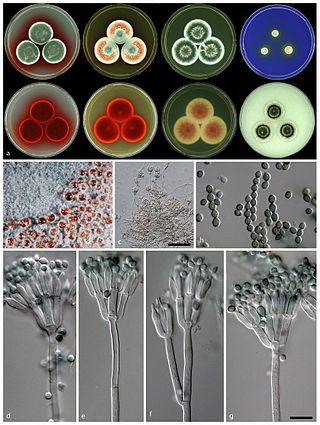
Penicillium is a genus of ascomycetous fungi that is part of the mycobiome of many species and is of major importance in the natural environment, in food spoilage, and in food and drug production.

Eurotiomycetes is a large class of ascomycetes with cleistothecial ascocarps within the subphylum Pezizomycotina, currently containing around 3810 species according to the Catalogue of Life. It is the third largest lichenized class, with more than 1200 lichen species that are mostly bitunicate in the formation of asci. It contains most of the fungi previously known morphologically as "Plectomycetes".

The Trichocomaceae are a family of fungi in the order Eurotiales. Taxa are saprobes with aggressive colonization strategies, adaptable to extreme environmental conditions. Family members are cosmopolitan in distribution, ubiquitous in soil, and common associates of decaying plant and food material.

Paecilomyces is a genus of fungi. A number of species in this genus are plant pathogens.

Talaromyces is a genus of fungi in the family Trichocomaceae. Described in 1955 by American mycologist Chester Ray Benjamin, species in the genus form soft, cottony fruit bodies (ascocarps) with cell walls made of tightly interwoven hyphae. The fruit bodies are often yellowish or are surrounded by yellowish granules. A 2008 estimate placed 42 species in the genus, but several new species have since been described.
Penicillium alfredii is a fungus species of the genus of Penicillium which is named after Alfred P. Sloan.
Penicillium dunedinense is a species of the genus of Penicillium which was isolated in Dunedin in New Zealand.
Penicillium ellipsoideosporum is a species of the genus of Penicillium which was isolated in China.
Penicillium inflatum is an anamorph species of the genus of Penicillium which produces sterigmatocystin. It is from the Cremei section.
Penicillium ehrlichii is a species of fungus in the genus Penicillium in the order of Eurotiales. In Penicillium, it is placed in the series Janthinella in the section Lanata-Divaricata.
Penicillium osmophilum is a species of fungus in the genus Penicillium which was isolated from agricultural soil in Wageningen in the Netherlands
Rasamsonia is a genus of fungi in the family Trichocomaceae, circumscribed in 2011 by mycologists Jos Houbraken and Jens Frisvad. It is characterized from other genera of the Trichocomaceae by the following combination of features: species are thermotolerant or thermophilic; their conidiophores have distinctly rough-walled stipes; conidia are olive brown; and ascomata, if present, have minimal covering. Rasamsonia phenotypically resembles Paecilomyces, in that both have thermotolerant species, produce olive-brown conidia, and form ascomata with no or scarce ascomatal covering; Rasamsonia, however, differs from Paecilomyces in having more regularly branched conidiophores with distinct rough-walled structures. The type species is Rasamsonia emersonii, a fungus formerly classified in the genus Talaromyces.
Thermoascus is a genus of soil fungi in the family Trichocomaceae. Species in the genus are characterized by the production of heat-resistant ascospores. Thermoascus was circumscribed by German botanist Hugo Miehe in 1907.
Aspergillus sloanii is a species of fungus in the genus Aspergillus. It is from the Aspergillus section. The species was first described in 2014. It has been reported to produce auroglaucin, bisanthrons, dihydroauroglaucin, echinulins, flavoglaucin, physcion, tetracyclic, and tetrahydroauroglaucin.
Aspergillus templicola is a species of fungus in the genus Aspergillus. It is from the Flavipedes section. The species was first described in 2014.
Monascaceae is a former family of fungi in the subclass Eurotiomycetidae.

The Aspergillaceae are a family of fungi in the order Eurotiales which are commonly known as the blue and green molds. The family includes the commonly known and observed genera of Aspergillus and Penicillium amongst other lesser known mold genera but also includes larger ascomycete fungi such as Penicilliopsis.
Paecilomyces formosus is a species of fungus in the genus Paecilomyces in the order of Eurotiales.
Circumdati is a subgenus of Aspergillus in the family Trichocomaceae.

Nidulantes is a subgenus of Aspergillus in the family Trichocomaceae.







